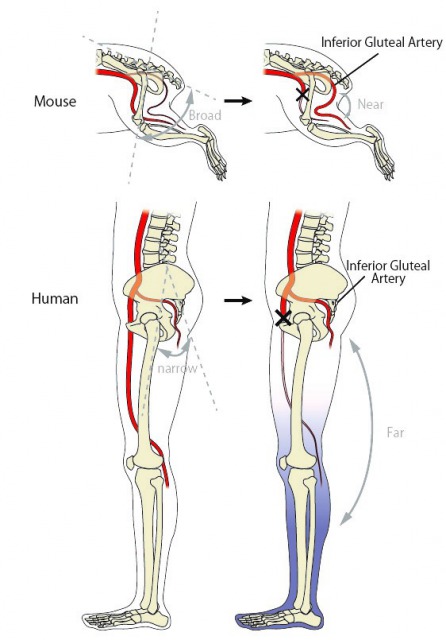Humans risked limb ischemia in exchange for bipedal walking -Detailed comparison of mouse and human blood vessels using three-dimensional imaging-
Peripheral obstructive arterial disease develops when blood vessels narrow due to arteriosclerosis and blood flow in the legs (or rarely the arms) becomes clogged. Intermittent claudication is when blood flow disturbances in the limb(s) cause pain, numbness, or coldness during physical activity. In severe cases, where the tissue has gone without blood for too long and dies, the limb may have to be amputated.Previous clinical and animal research showed that mice receive less tissue damage under ischemic condition than humans, however, it was not clear what caused the difference. To clarify why humans seem to be at a disadvantage in this situation, researchers from Kumamoto University focused on collateral vessels that could bypass obstructed blood vessels. Using a murine lower limb ischemia model they compared the shape of mouse lower limb blood vessels with the vessels of a patient who had peripheral obstructive artery disease.
There are techniques, such as radiography, that can be used to visualize the small blood vessels of a mouse but they all produce only two-dimensional images. To obtain more detail, the researchers elected to use a system built by a collaboration of engineering and medical science researchers that established a method for stereoscopic visualization of small structures, the micro X-ray CT. This allowed for the detailed visualization of mouse blood vessels through soft tissue and around bone.
The micro CT scans clarified that when the hind limb of a mouse suffers from ischemia, the inferior gluteal artery expands and functions as a bypass. Even in human patients with peripheral obstructive artery disease, detailed diagnostic images revealed that the inferior gluteal artery expands in response to vascular stenosis (vessel hardening).
Importantly, the researchers also showed that the inferior gluteal artery of the mouse extends to the lower leg area whereas the human inferior gluteal artery ends at the buttock. Consequently, the mouse vascular structure is more robust against lower limb ischemia than the human vascular structure.
"Two things are believed to be the causes of the inhibited development of the inferior gluteal artery in humans," said Assistant Professor Yuichiro Arima, who led the study. "One is that the development of the artery is restricted by the skeletal change accompanying bipedal walking, and the other is that, over time, the distance from the pelvis to the lower leg has become too distant. In other words, human beings are at a risk of lower limb ischemia due to evolution. This understanding is expected to lead to the development of a treatment that strengthens collateral circulation pathways for people suffering from peripheral obstructive arterial disease."
This research result was posted online in the "Journal of American Heart Association" on 23 March, 2018.
[Paper Info]
TITLE:
Evaluation of collateral source characteristics with three-dimensional analysis using micro X-ray computed tomography
AUTHORS:
Yuichiro Arima, Seiji Hokimoto, Noriaki Tabata, Osamu Nakagawa, Asahi Oshima, Yosuke Matsumoto, Takahiro Sato, Toshifumi Mukunoki, Jun Otani, Masanobu Ishii, Michie Uchikawa, Eiichiro Yamamoto, Yasuhiro Izumiya, Koichi Kaikita, Hisao Ogawa, Koichi Nishiyama and Kenichi Tsujita
JOURNAL:
Journal of American Heart Association
DOI:
https://doi.org/10.1161/JAHA.117.007800
URL:
http://jaha.ahajournals.org/content/7/6/e007800
[Fund]
KAKENHI
[Image1]

Stereoscopic image of murine lower limb blood vessels using micro X-ray CT
CAPTION:
Micro X-ray CT scans reveal the reason why mice do not suffer as much tissue damage under ischemic conditions as humans. Their inferior gluteal artery provides a more effective bridge around blood clots in the femoral artery.
[Image2]

Underlying arteries in mice and humans, and changes in femoral artery occlusion
CAPTION:
Pathways of the underlying arteries in mice and humans, and changes in femoral artery occlusion (right). When the femoral artery becomes occluded in the mouse, the inferior gluteal artery provides a path around it to the lower leg. In humans, the inferior gluteal artery stops at the buttocks and cannot send blood to the lower leg where it is needed during an occlusion.
[movie]
Micro X-ray CT scan of a mouse hind limb defect
(Link to EurekAlert! website)
CAPTION:
Video of mouse hind limbs one month after induction of ischemia via ligation in the left hind limb. Compared to the right hind limb, a plurality of blood vessels, called collateral arteries, are visible in the left limb and function as a bypass around the ligation.
[Images and movie Details]
CREDIT: Dr. Yuichiro Arima
USAGE RESTRICTIONS: These images and movie may only be used in conjunction with the accompanying release, or stories written about the work described in the release with reference to the original work.

